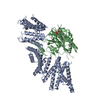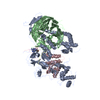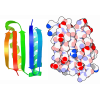[English] 日本語
 Yorodumi
Yorodumi- PDB-6vwj: Leg region of the closed conformation of the human type 1 insulin... -
+ Open data
Open data
- Basic information
Basic information
| Entry | Database: PDB / ID: 6vwj | |||||||||
|---|---|---|---|---|---|---|---|---|---|---|
| Title | Leg region of the closed conformation of the human type 1 insulin-like growth factor receptor ectodomain in complex with human insulin-like growth factor II | |||||||||
 Components Components | Leucine-zippered human type 1 insulin-like growth factor receptor ectodomain | |||||||||
 Keywords Keywords |  SIGNALING PROTEIN / Type 1 insulin-like growth factor receptor / SIGNALING PROTEIN / Type 1 insulin-like growth factor receptor /  Insulin-like growth factor II / ectodomain receptor / Insulin-like growth factor II / ectodomain receptor /  tyrosine kinase tyrosine kinase | |||||||||
| Function / homology |  Function and homology information Function and homology informationcardiac atrium development / negative regulation of cholangiocyte apoptotic process /  insulin-like growth factor receptor activity / positive regulation of steroid hormone biosynthetic process / insulin-like growth factor receptor activity / positive regulation of steroid hormone biosynthetic process /  protein kinase complex / Signaling by Type 1 Insulin-like Growth Factor 1 Receptor (IGF1R) / protein transporter activity / IRS-related events triggered by IGF1R / protein kinase complex / Signaling by Type 1 Insulin-like Growth Factor 1 Receptor (IGF1R) / protein transporter activity / IRS-related events triggered by IGF1R /  insulin-like growth factor binding / negative regulation of muscle cell apoptotic process ...cardiac atrium development / negative regulation of cholangiocyte apoptotic process / insulin-like growth factor binding / negative regulation of muscle cell apoptotic process ...cardiac atrium development / negative regulation of cholangiocyte apoptotic process /  insulin-like growth factor receptor activity / positive regulation of steroid hormone biosynthetic process / insulin-like growth factor receptor activity / positive regulation of steroid hormone biosynthetic process /  protein kinase complex / Signaling by Type 1 Insulin-like Growth Factor 1 Receptor (IGF1R) / protein transporter activity / IRS-related events triggered by IGF1R / protein kinase complex / Signaling by Type 1 Insulin-like Growth Factor 1 Receptor (IGF1R) / protein transporter activity / IRS-related events triggered by IGF1R /  insulin-like growth factor binding / negative regulation of muscle cell apoptotic process / cellular response to progesterone stimulus / positive regulation of DNA metabolic process / protein localization to nuclear periphery / FCERI mediated MAPK activation / cellular response to zinc ion starvation / cellular response to aldosterone / Activation of the AP-1 family of transcription factors / response to amino acid starvation / insulin-like growth factor binding / negative regulation of muscle cell apoptotic process / cellular response to progesterone stimulus / positive regulation of DNA metabolic process / protein localization to nuclear periphery / FCERI mediated MAPK activation / cellular response to zinc ion starvation / cellular response to aldosterone / Activation of the AP-1 family of transcription factors / response to amino acid starvation /  mediator complex binding / negative regulation of ribosomal protein gene transcription by RNA polymerase II / positive regulation of cellular response to amino acid starvation / mediator complex binding / negative regulation of ribosomal protein gene transcription by RNA polymerase II / positive regulation of cellular response to amino acid starvation /  insulin receptor complex / cellular response to testosterone stimulus / negative regulation of hepatocyte apoptotic process / insulin receptor complex / cellular response to testosterone stimulus / negative regulation of hepatocyte apoptotic process /  insulin-like growth factor I binding / insulin-like growth factor I binding /  insulin receptor activity / insulin receptor activity /  transcytosis / Oxidative Stress Induced Senescence / nitrogen catabolite activation of transcription from RNA polymerase II promoter / alphav-beta3 integrin-IGF-1-IGF1R complex / response to alkaloid / positive regulation of protein-containing complex disassembly / cellular response to angiotensin / transcytosis / Oxidative Stress Induced Senescence / nitrogen catabolite activation of transcription from RNA polymerase II promoter / alphav-beta3 integrin-IGF-1-IGF1R complex / response to alkaloid / positive regulation of protein-containing complex disassembly / cellular response to angiotensin /  dendritic spine maintenance / cellular response to insulin-like growth factor stimulus / response to L-glutamate / dendritic spine maintenance / cellular response to insulin-like growth factor stimulus / response to L-glutamate /  insulin binding / negative regulation of MAPK cascade / establishment of cell polarity / positive regulation of axon regeneration / amyloid-beta clearance / positive regulation of osteoblast proliferation / positive regulation of cytokinesis / TFIID-class transcription factor complex binding / regulation of JNK cascade / insulin binding / negative regulation of MAPK cascade / establishment of cell polarity / positive regulation of axon regeneration / amyloid-beta clearance / positive regulation of osteoblast proliferation / positive regulation of cytokinesis / TFIID-class transcription factor complex binding / regulation of JNK cascade /  estrous cycle / estrous cycle /  insulin receptor substrate binding / G-protein alpha-subunit binding / positive regulation of transcription initiation by RNA polymerase II / response to vitamin E / amino acid biosynthetic process / SHC-related events triggered by IGF1R / positive regulation of RNA polymerase II transcription preinitiation complex assembly / insulin receptor substrate binding / G-protein alpha-subunit binding / positive regulation of transcription initiation by RNA polymerase II / response to vitamin E / amino acid biosynthetic process / SHC-related events triggered by IGF1R / positive regulation of RNA polymerase II transcription preinitiation complex assembly /  phosphatidylinositol 3-kinase binding / peptidyl-tyrosine autophosphorylation / phosphatidylinositol 3-kinase binding / peptidyl-tyrosine autophosphorylation /  T-tubule / cellular response to transforming growth factor beta stimulus / cellular response to amino acid starvation / cerebellum development / T-tubule / cellular response to transforming growth factor beta stimulus / cellular response to amino acid starvation / cerebellum development /  axonogenesis / cellular response to dexamethasone stimulus / insulin-like growth factor receptor signaling pathway / phosphatidylinositol 3-kinase/protein kinase B signal transduction / axonogenesis / cellular response to dexamethasone stimulus / insulin-like growth factor receptor signaling pathway / phosphatidylinositol 3-kinase/protein kinase B signal transduction /  caveola / cellular response to estradiol stimulus / hippocampus development / cellular response to glucose stimulus / positive regulation of smooth muscle cell proliferation / response to nicotine / caveola / cellular response to estradiol stimulus / hippocampus development / cellular response to glucose stimulus / positive regulation of smooth muscle cell proliferation / response to nicotine /  insulin receptor binding / insulin receptor binding /  receptor protein-tyrosine kinase / cellular response to mechanical stimulus / RNA polymerase II transcription regulator complex / cellular response to amyloid-beta / : / receptor protein-tyrosine kinase / cellular response to mechanical stimulus / RNA polymerase II transcription regulator complex / cellular response to amyloid-beta / : /  cellular senescence / insulin receptor signaling pathway / positive regulation of cold-induced thermogenesis / DNA-binding transcription activator activity, RNA polymerase II-specific / cellular senescence / insulin receptor signaling pathway / positive regulation of cold-induced thermogenesis / DNA-binding transcription activator activity, RNA polymerase II-specific /  protein tyrosine kinase activity / response to ethanol / RNA polymerase II-specific DNA-binding transcription factor binding / protein tyrosine kinase activity / response to ethanol / RNA polymerase II-specific DNA-binding transcription factor binding /  transcription regulator complex / sequence-specific DNA binding / positive regulation of MAPK cascade / protein autophosphorylation / Extra-nuclear estrogen signaling / positive regulation of phosphatidylinositol 3-kinase/protein kinase B signal transduction / transcription regulator complex / sequence-specific DNA binding / positive regulation of MAPK cascade / protein autophosphorylation / Extra-nuclear estrogen signaling / positive regulation of phosphatidylinositol 3-kinase/protein kinase B signal transduction /  receptor complex / DNA-binding transcription factor activity, RNA polymerase II-specific / receptor complex / DNA-binding transcription factor activity, RNA polymerase II-specific /  regulation of cell cycle / intracellular signal transduction / positive regulation of cell migration / regulation of cell cycle / intracellular signal transduction / positive regulation of cell migration /  immune response / RNA polymerase II cis-regulatory region sequence-specific DNA binding / DNA-binding transcription factor activity / immune response / RNA polymerase II cis-regulatory region sequence-specific DNA binding / DNA-binding transcription factor activity /  axon / intracellular membrane-bounded organelle / neuronal cell body / axon / intracellular membrane-bounded organelle / neuronal cell body /  chromatin binding chromatin bindingSimilarity search - Function | |||||||||
| Biological species |   Homo sapiens (human) Homo sapiens (human)  Saccharomyces cerevisiae (brewer's yeast) Saccharomyces cerevisiae (brewer's yeast) | |||||||||
| Method |  ELECTRON MICROSCOPY / ELECTRON MICROSCOPY /  single particle reconstruction / single particle reconstruction /  cryo EM / Resolution: 4.21 Å cryo EM / Resolution: 4.21 Å | |||||||||
 Authors Authors | Xu, Y. / Kirk, N.S. / Lawrence, M.C. / Croll, T.I. | |||||||||
| Funding support |  Australia, Australia,  United Kingdom, 2items United Kingdom, 2items
| |||||||||
 Citation Citation |  Journal: Structure / Year: 2020 Journal: Structure / Year: 2020Title: How IGF-II Binds to the Human Type 1 Insulin-like Growth Factor Receptor. Authors: Yibin Xu / Nicholas S Kirk / Hariprasad Venugopal / Mai B Margetts / Tristan I Croll / Jarrod J Sandow / Andrew I Webb / Carlie A Delaine / Briony E Forbes / Michael C Lawrence /   Abstract: Human type 1 insulin-like growth factor receptor (IGF-1R) signals chiefly in response to the binding of insulin-like growth factor I. Relatively little is known about the role of insulin-like growth ...Human type 1 insulin-like growth factor receptor (IGF-1R) signals chiefly in response to the binding of insulin-like growth factor I. Relatively little is known about the role of insulin-like growth factor II signaling via IGF-1R, despite the affinity of insulin-like growth factor II for IGF-1R being within an order of magnitude of that of insulin-like growth factor I. Here, we describe the cryoelectron microscopy structure of insulin-like growth factor II bound to a leucine-zipper-stabilized IGF-1R ectodomain, determined in two conformations to a maximum average resolution of 3.2 Å. The two conformations differ in the relative separation of their respective points of membrane entry, and comparison with the structure of insulin-like growth factor I bound to IGF-1R reveals long-suspected differences in the way in which the critical C domain of the respective growth factors interact with IGF-1R. | |||||||||
| History |
|
- Structure visualization
Structure visualization
| Movie |
 Movie viewer Movie viewer |
|---|---|
| Structure viewer | Molecule:  Molmil Molmil Jmol/JSmol Jmol/JSmol |
- Downloads & links
Downloads & links
- Download
Download
| PDBx/mmCIF format |  6vwj.cif.gz 6vwj.cif.gz | 275.2 KB | Display |  PDBx/mmCIF format PDBx/mmCIF format |
|---|---|---|---|---|
| PDB format |  pdb6vwj.ent.gz pdb6vwj.ent.gz | 219.5 KB | Display |  PDB format PDB format |
| PDBx/mmJSON format |  6vwj.json.gz 6vwj.json.gz | Tree view |  PDBx/mmJSON format PDBx/mmJSON format | |
| Others |  Other downloads Other downloads |
-Validation report
| Arichive directory |  https://data.pdbj.org/pub/pdb/validation_reports/vw/6vwj https://data.pdbj.org/pub/pdb/validation_reports/vw/6vwj ftp://data.pdbj.org/pub/pdb/validation_reports/vw/6vwj ftp://data.pdbj.org/pub/pdb/validation_reports/vw/6vwj | HTTPS FTP |
|---|
-Related structure data
| Related structure data |  21418MC  6vwgC  6vwhC  6vwiC C: citing same article ( M: map data used to model this data |
|---|---|
| Similar structure data |
- Links
Links
- Assembly
Assembly
| Deposited unit | 
|
|---|---|
| 1 |
|
- Components
Components
| #1: Protein | Mass: 108937.242 Da / Num. of mol.: 2 Source method: isolated from a genetically manipulated source Source: (gene. exp.)   Homo sapiens (human), (gene. exp.) Homo sapiens (human), (gene. exp.)   Saccharomyces cerevisiae (strain ATCC 204508 / S288c) (yeast) Saccharomyces cerevisiae (strain ATCC 204508 / S288c) (yeast)Gene: IGF1R, GCN4, AAS3, ARG9, YEL009C / Plasmid: pEE14 / Strain: ATCC 204508 / S288c / Cell line (production host): CHO-K1 / Production host:   Cricetulus griseus (Chinese hamster) Cricetulus griseus (Chinese hamster)References: UniProt: P08069, UniProt: P03069,  receptor protein-tyrosine kinase receptor protein-tyrosine kinase |
|---|
-Experimental details
-Experiment
| Experiment | Method:  ELECTRON MICROSCOPY ELECTRON MICROSCOPY |
|---|---|
| EM experiment | Aggregation state: PARTICLE / 3D reconstruction method:  single particle reconstruction single particle reconstruction |
- Sample preparation
Sample preparation
| Component | Name: Leg region of the open-leg conformation of the human type 1 insulin-like growth factor receptor ectodomain in complex with human insulin-like growth factor II Type: COMPLEX / Entity ID: all / Source: MULTIPLE SOURCES | ||||||||||||||||||||
|---|---|---|---|---|---|---|---|---|---|---|---|---|---|---|---|---|---|---|---|---|---|
| Molecular weight | Value: 0.25 MDa / Experimental value: NO | ||||||||||||||||||||
| Source (natural) | Organism:   Homo sapiens (human) Homo sapiens (human) | ||||||||||||||||||||
| Source (recombinant) | Organism:   Cricetulus griseus (Chinese hamster) Cricetulus griseus (Chinese hamster) | ||||||||||||||||||||
| Buffer solution | pH: 7.5 | ||||||||||||||||||||
| Buffer component |
| ||||||||||||||||||||
| Specimen | Conc.: 0.1 mg/ml / Embedding applied: NO / Shadowing applied: NO / Staining applied : NO / Vitrification applied : NO / Vitrification applied : YES / Details: IGFII:IGF-1R molar ratio 1.5:1 : YES / Details: IGFII:IGF-1R molar ratio 1.5:1 | ||||||||||||||||||||
| Specimen support | Details: 15mA current / Grid material: GOLD / Grid mesh size: 300 divisions/in. / Grid type: Quantifoil, UltrAuFoil, R1.2/1.3 | ||||||||||||||||||||
Vitrification | Instrument: FEI VITROBOT MARK IV / Cryogen name: ETHANE / Humidity: 100 % / Chamber temperature: 277 K |
- Electron microscopy imaging
Electron microscopy imaging
| Experimental equipment |  Model: Titan Krios / Image courtesy: FEI Company |
|---|---|
| Microscopy | Model: FEI TITAN KRIOS |
| Electron gun | Electron source : :  FIELD EMISSION GUN / Accelerating voltage: 300 kV / Illumination mode: FLOOD BEAM FIELD EMISSION GUN / Accelerating voltage: 300 kV / Illumination mode: FLOOD BEAM |
| Electron lens | Mode: BRIGHT FIELD Bright-field microscopy / Cs Bright-field microscopy / Cs : 2.7 mm / C2 aperture diameter: 50 µm : 2.7 mm / C2 aperture diameter: 50 µm |
| Specimen holder | Cryogen: NITROGEN |
| Image recording | Average exposure time: 10 sec. / Electron dose: 50 e/Å2 / Detector mode: COUNTING / Film or detector model: GATAN K2 SUMMIT (4k x 4k) / Num. of grids imaged: 1 / Num. of real images: 4585 |
| EM imaging optics | Energyfilter name : GIF Quantum LS : GIF Quantum LS |
| Image scans | Movie frames/image: 50 / Used frames/image: 1-50 |
- Processing
Processing
| Software |
| ||||||||||||||||||||||||||||||||
|---|---|---|---|---|---|---|---|---|---|---|---|---|---|---|---|---|---|---|---|---|---|---|---|---|---|---|---|---|---|---|---|---|---|
| EM software |
| ||||||||||||||||||||||||||||||||
CTF correction | Type: PHASE FLIPPING AND AMPLITUDE CORRECTION | ||||||||||||||||||||||||||||||||
| Particle selection | Num. of particles selected: 2057701 | ||||||||||||||||||||||||||||||||
| Symmetry | Point symmetry : C1 (asymmetric) : C1 (asymmetric) | ||||||||||||||||||||||||||||||||
3D reconstruction | Resolution: 4.21 Å / Resolution method: FSC 0.143 CUT-OFF / Num. of particles: 108899 / Symmetry type: POINT | ||||||||||||||||||||||||||||||||
| Atomic model building | Protocol: FLEXIBLE FIT / Space: REAL Details: UCSF Chimera was used for the initial fitting and ISOLDE v 1.03b was using for flexible fitting. | ||||||||||||||||||||||||||||||||
| Atomic model building | PDB-ID: 5U8R | ||||||||||||||||||||||||||||||||
| Refinement | Cross valid method: NONE Stereochemistry target values: GeoStd + Monomer Library + CDL v1.2 | ||||||||||||||||||||||||||||||||
| Displacement parameters | Biso mean: 139.51 Å2 | ||||||||||||||||||||||||||||||||
| Refine LS restraints |
|
 Movie
Movie Controller
Controller















 PDBj
PDBj











